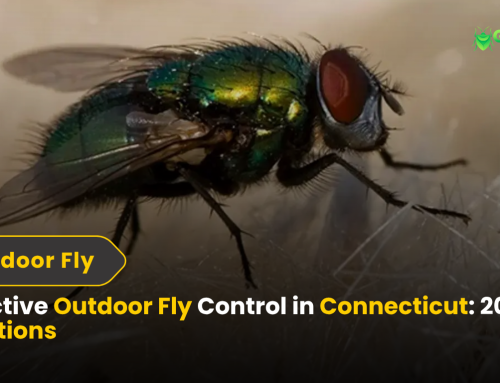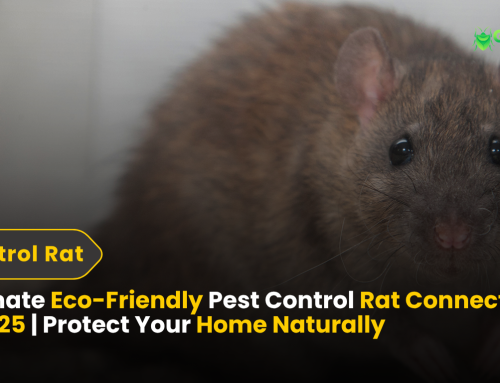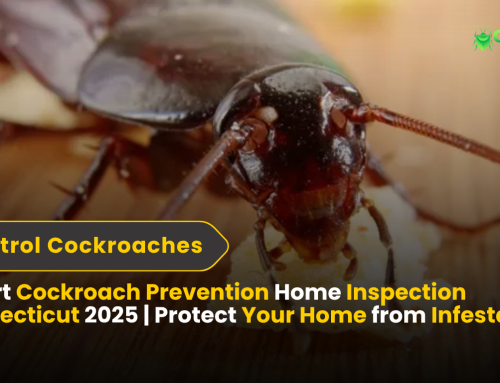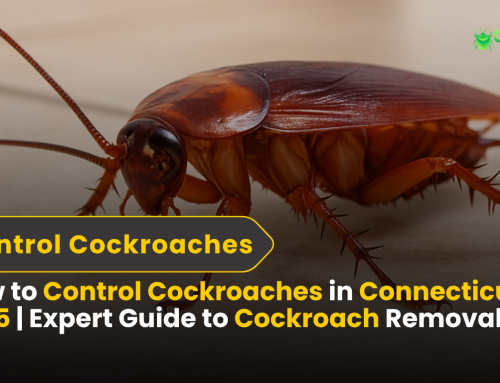Are Centipedes Poisonous? Exploring The Myths, Facts, and Practical Solutions In 2025
Centipedes are intriguing yet often misunderstood creatures that have fascinated and frightened humans for centuries. Their long, segmented bodies, numerous legs, and swift movements make them an unsettling sight in homes, gardens, and forests. Despite their creepy appearance, centipedes play a vital role in ecosystems as natural predators of smaller insects and pests. However, many people fear them due to concerns about their venom and potential harm to humans and pets.
This article dives deep into the biology and behavior of centipedes, addressing the common question: Are centipedes poisonous? We’ll explore their anatomy, the nature of their venom, risks posed to humans and animals, and practical ways to manage or coexist with these arthropods.
What Are Centipedes? A Quick Overview
- Scientific Classification: Centipedes belong to the class Chilopoda, a group of arthropods characterized by elongated, segmented bodies and jointed appendages.
- Leg Count: Despite their name, centipedes rarely have exactly 100 legs. Their leg count varies by species, ranging from 15 to over 300.
- Habitat: Found worldwide, centipedes thrive in diverse environments, from forests to urban basements, and prefer damp areas like leaf litter, under rocks, or bathroom crevices.
- Diet: Carnivorous by nature, centipedes feed on insects, spiders, and other small arthropods, making them effective pest controllers.
Are Centipedes Poisonous or Venomous?
When it comes to centipedes, it’s crucial to understand the difference between the terms poisonous and venomous, as they are often used interchangeably but actually have distinct meanings:
- Poisonous: This refers to organisms that release toxins when they are ingested, touched, or otherwise interacted with. For example, eating a poisonous plant or animal could result in poisoning.
- Venomous: In contrast, venomous organisms actively inject toxins into their target through a bite, sting, or similar mechanism. Venom is typically used to immobilize prey, defend against predators, or help with digestion.
Centipedes are venomous, not poisonous. Their venom is delivered through their forcipules, which are specialized, modified front legs designed to inject venom into their prey. This venom serves multiple purposes: it helps subdue and immobilize prey, often insects or other small arthropods, and begins the digestive process by breaking down the prey’s tissue. The venom also serves as a defense mechanism against predators, including humans and larger animals.
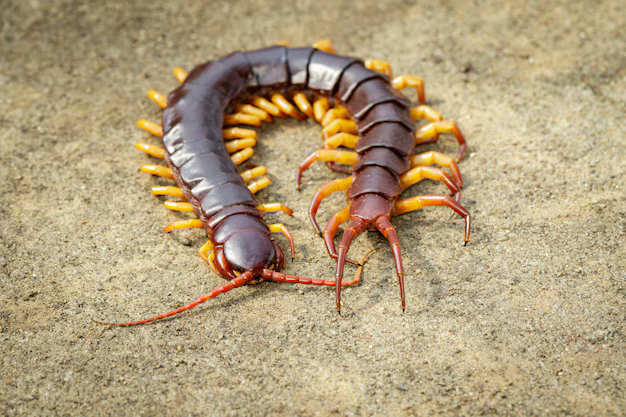
How Centipede Venom Works
Centipede venom is a mixture of various toxins, enzymes, and proteins. These substances work together to achieve the following effects on prey:
- Paralysis and Immobilization: The venom quickly paralyzes the prey, making it easier for the centipede to consume.
- Digestive Aid: Some of the enzymes in the venom start breaking down the tissues of the prey, liquefying it, which aids in digestion.
- Defense: For larger animals or predators, the venom serves to deter attacks, causing pain or irritation.
The venom is delivered via the centipede’s forcipules, which are positioned on the first body segment and look like pincers. These forcipules are sharp and equipped to pierce through the skin or exoskeleton of their prey, allowing the venom to be injected efficiently.
Effects on Humans
While centipedes are indeed venomous, their venom is typically not dangerous to humans in most cases. When a centipede bites, it usually results in the following:
- Mild to Moderate Discomfort: A bite from a typical house centipede (such as Scutigera coleoptrata) generally causes mild irritation, similar to the sting of a bee. You might experience redness, swelling, and pain around the bite site, which generally lasts a few hours.
- More Severe Reactions: In the case of larger species, such as the giant centipede (Scolopendra), the venom can cause more intense pain, localized swelling, and even systemic symptoms like fever, nausea, or dizziness. Although such reactions are usually self-limiting, the severity can be alarming, especially in the case of large species.
Factors Influencing Severity
- Species: Larger species of pests like the giant centipede have more potent venom that can cause more noticeable symptoms, while smaller species typically cause minimal effects.
- Amount of Venom Injected: A single bite may deliver only a small amount of venom, which may not cause much more than temporary irritation. However, larger bites or multiple bites could increase the amount of venom entering the body, causing stronger reactions.
- Individual Sensitivity: People’s reactions to centipede venom can vary. Some may experience only slight discomfort, while others may have a stronger reaction, including a more pronounced swelling or pain. This is especially true for individuals who are more sensitive to insect venom in general.
Bite Likelihood and Circumstances
Centipedes, by nature, are not aggressive toward humans. They will typically avoid human interaction and only bite when they feel threatened or provoked. They are more likely to bite if handled directly, stepped on, or trapped between a person’s skin and a surface (like when reaching under furniture or into crevices).
- Bite Likelihood: Centipedes rarely bite humans unless they are provoked, and most bites occur when the centipede is inadvertently disturbed.
- Behavior: If left undisturbed, centipedes are shy creatures and will generally avoid contact with humans, preferring to stay hidden in damp, dark places.
Key Facts to Remember
- Bite Likelihood: While centipedes are venomous, they don’t typically bite unless provoked. Centipedes are shy and prefer to avoid humans.
- Venom Effects: The venom from centipedes is generally not harmful to humans in most cases. The severity of symptoms depends on factors such as the species of centipede, the amount of venom injected, and the individual’s sensitivity to the venom.
- Species Variability: While house centipedes (1–2 inches long) rarely cause anything more than mild irritation, larger species like the giant centipede (Scolopendra) can cause significantly more pain and discomfort.
- Preventing Bites: Avoid handling centipedes, and take care when reaching into areas where they may be hiding, like basements, bathrooms, or under furniture.
Common Centipede Species and Their Risks
- House Centipedes (Scutigera coleoptrata)
- Size: 1–2 inches.
- Appearance: Long legs and rapid movements.
- Risk: Minimal; bites are rare and cause mild irritation.
- Giant Centipedes (Scolopendra spp.)
- Size: Up to 12 inches.
- Habitat: Tropical and subtropical regions.
- Risk: Painful bites that may cause localized swelling or systemic symptoms.
- Stone Centipedes
- Size: Typically less than 1 inch.
- Risk: Harmless to humans.
Symptoms of Centipede Bites
- Common Symptoms:
- Redness
- Swelling
- Pain or irritation
- Less Common Symptoms:
- Nausea or dizziness
- Mild fever
- Rare Symptoms:
- Severe allergic reactions (e.g., anaphylaxis)
When to Seek Medical Attention
- Symptoms persist beyond 24 hours.
- Signs of severe allergic reactions (e.g., difficulty breathing).
Practical Solutions: What to Do If Bitten by a Centipede
A centipede bite can be an unpleasant experience, but it is usually not dangerous. Understanding how to properly address the bite can help minimize discomfort and prevent any complications. Here’s a detailed guide on how to handle a centipede bite:
Immediate First Aid for a Centipede Bite
- Wash the Bite Area with Soap and Water
- Why: Cleaning the bite area immediately is crucial to prevent infection. The skin may be broken slightly from the bite, and washing it helps remove any dirt or bacteria that could cause infection.
- How: Use mild soap and lukewarm water to gently wash the affected area. Avoid scrubbing, which could irritate the skin further.
- Apply a Cold Compress to Reduce Swelling and Numb the Pain
- Why: Cold therapy can help reduce inflammation, numb the pain, and soothe the skin. It constricts blood vessels, which limits the amount of swelling around the bite.
- How: Wrap a clean cloth around a few ice cubes or use a cold pack, and gently press it against the bite area for 10–15 minutes at a time. Be sure to avoid direct contact between ice and the skin to prevent frostbite.
Over-the-Counter Remedies
- Pain Relievers (e.g., Ibuprofen or Acetaminophen)
- Why: Over-the-counter pain relievers can help reduce pain and inflammation, making the bite less uncomfortable.
- How: Follow the dosage instructions on the packaging, and take the appropriate medication to alleviate the pain. Ibuprofen (Advil) can also help reduce swelling and inflammation, while acetaminophen (Tylenol) is effective for pain relief.
- Antihistamines to Reduce Inflammation
- Why: Antihistamines help to counteract any allergic reactions or itching that may occur after a centipede bite. These medications can also reduce swelling caused by the venom.
- How: Over-the-counter antihistamines such as Benadryl (diphenhydramine) or Claritin (loratadine) can provide relief. Be cautious of drowsiness that may occur with some antihistamines, particularly older formulations like Benadryl.
Home Remedies for Centipede Bites
- Turmeric Paste
- Why: Turmeric contains curcumin, which is a powerful anti-inflammatory compound. Applying a turmeric paste to the bite can help reduce swelling, relieve pain, and speed up healing.
- How: Mix a small amount of turmeric powder with water to create a thick paste. Apply the paste directly to the bite area and leave it on for 10–15 minutes before rinsing off with lukewarm water. Repeat 2–3 times a day.
- Aloe Vera Gel
- Why: Aloe vera is known for its soothing and cooling properties. It helps moisturize the skin, reduce inflammation, and promote healing. It’s particularly effective for burns and bites.
- How: Apply fresh aloe vera gel directly from the plant or use an over-the-counter gel. Gently rub it into the bite area, and allow it to dry naturally. Reapply a few times a day for relief.
When to Seek Medical Attention
While most centipede bites are mild and self-limiting, there are situations where seeking medical attention is necessary. If any of the following occur, it’s important to consult a healthcare provider:
- Symptoms Worsen or Do Not Improve
- If the pain or swelling increases instead of subsiding after a few hours or days, or if the bite site becomes increasingly red or warm to the touch, it could be a sign of infection. An infection requires medical treatment, possibly including antibiotics.
- Signs of an Allergic Reaction
- If you experience difficulty breathing, swelling around the face or throat, or tightness in the chest, these could be signs of a severe allergic reaction (anaphylaxis), which requires immediate medical attention. Anaphylaxis is a medical emergency, and you should seek help as soon as possible.
- Severe Systemic Symptoms
- While rare, centipede venom can cause more widespread symptoms in sensitive individuals. If you experience nausea, vomiting, dizziness, or fever that lasts for more than 24 hours, it’s important to consult a healthcare professional. These symptoms may indicate a more significant reaction to the venom, particularly from larger species like the giant centipede.
- Infection Signs
- If you notice pus coming from the bite, or if the area develops a feverish warmth and feels tender to the touch, these may be signs of an infection that needs to be treated with antibiotics. Prompt medical care can prevent the infection from worsening.
Prevention Tips for Avoiding Centipede Bites
- Avoid Handling Centipedes: As with any wild creature, it’s best to leave centipedes alone. Avoid touching or picking them up, as this increases the likelihood of getting bitten.
- Wear Gloves: When cleaning areas where centipedes may hide, like basements or attics, wear gloves to prevent accidental contact.
- Keep Areas Clean: Since centipedes are attracted to moisture and damp environments, ensure that your home is dry and well-ventilated to discourage their presence.
- Seal Entry Points: Prevent centipedes from entering your home by sealing cracks and crevices around windows, doors, and foundations.
How to Prevent Centipede Infestations: A Detailed Guide
Centipedes are typically attracted to environments with high moisture levels, easy access points, and places to hide. Taking proactive steps to eliminate the conditions that invite centipedes into your home can significantly reduce the likelihood of infestations. Here’s a comprehensive guide on how to prevent centipedes from becoming unwelcome houseguests:
1. Moisture Control: Reducing the Attractiveness of Your Home
Centipedes thrive in damp environments, so controlling moisture is one of the most effective strategies for keeping them at bay. Here’s how to address moisture issues:
Fix Leaks in Bathrooms, Kitchens, and Basements
- Why: Leaky pipes and faucets create a constant source of moisture that centipedes find attractive. These areas, if left unchecked, become breeding grounds for centipedes and other pests.
- How: Regularly inspect all plumbing systems in moisture-prone areas of the home. If you notice any leaks, repair them immediately to prevent water accumulation. Replace or seal old, worn-out seals around sinks, bathtubs, and shower stalls.
Use Dehumidifiers in Damp Areas
- Why: Dehumidifiers can help reduce the overall humidity in areas like basements, bathrooms, and laundry rooms, which is key to preventing centipedes from settling in.
- How: Place dehumidifiers in the areas with the highest moisture levels. Aim to keep the humidity level below 50%, as centipedes are less likely to thrive in drier conditions. If you don’t have a dehumidifier, you can also improve ventilation by opening windows (if weather permits) or installing fans.
Improve Ventilation
- Why: Proper airflow helps reduce moisture buildup in areas like attics, crawl spaces, and basements, where centipedes are commonly found.
- How: Ensure that your home has adequate ventilation. Install exhaust fans in bathrooms and kitchens to pull out excess humidity, and use attic vents to allow air to circulate freely. In the basement, consider installing air vents or using a fan to improve airflow.
2. Seal Entry Points: Keeping Centipedes Out
Centipedes often find their way indoors through small cracks, gaps, and crevices around the home. Sealing these entry points is essential in preventing infestations.
Close Cracks and Gaps Around Windows, Doors, and Foundations
- Why: Gaps around windows, doors, and foundations offer easy access for centipedes and other pests to enter your home.
- How: Inspect the exterior of your home, paying close attention to door frames, window seals, and foundation cracks. Seal any gaps with high-quality caulk or weather stripping. Check for holes or cracks in the foundation, and seal them using mortar or concrete sealant. Install door sweeps to cover gaps at the bottom of doors.
Install Mesh Screens on Vents and Chimneys
- Why: Vents and chimneys can serve as entryways for centipedes and other insects. Installing fine mesh screens can block them from entering while allowing for airflow.
- How: Use wire mesh or screen material with small holes (no larger than 1/8 inch) to cover vents, chimneys, and other openings. Ensure the mesh is securely fastened to prevent pests from slipping through.
3. Declutter: Minimizing Hiding Spots for Centipedes
Centipedes seek shelter in dark, hidden places where they can stay safe and moisture-rich. Decluttering your home reduces the number of potential hiding spots they can occupy.
Remove Piles of Leaves, Wood, or Unused Items
- Why: Centipedes are attracted to places where they can hide and thrive. Piles of leaves, wood, and other debris around the foundation of your house provide the perfect habitat for them.
- How: Keep the perimeter of your house free from piles of leaves, mulch, or firewood. If you have a woodpile, store it off the ground and away from your home. Inside, make sure basements, attics, and closets are organized, and avoid accumulating clutter in dark corners or under furniture. Keep items elevated off the floor whenever possible.
Maintain Landscaping
- Why: Tall grass, overgrown shrubs, and thick vegetation near your home can create humid, sheltered environments that attract centipedes.
- How: Trim shrubs and bushes, especially those near windows, doors, and vents. Keep your lawn neatly mowed and remove any piles of organic matter, such as leaves or grass clippings. Consider using gravel or rocks along the foundation of your home instead of mulch, as it is less likely to retain moisture.
4. Use Natural Repellents: Deter Centipedes Without Chemicals
Several natural repellents can help deter centipedes from entering or inhabiting your home. These solutions are eco-friendly and non-toxic to pets and children.
Apply Diatomaceous Earth Near Entry Points
- Why: Diatomaceous earth (DE) is a natural substance made from fossilized remains of tiny aquatic organisms called diatoms. It acts as a desiccant, drying out the bodies of insects, including centipedes, when they come into contact with it.
- How: Sprinkle a thin layer of food-grade diatomaceous earth around the perimeter of your home, especially near doors, windows, and cracks. Be sure to apply it in areas where it will remain dry and undisturbed, as moisture reduces its effectiveness.
Use Essential Oils Like Peppermint or Tea Tree Oil
- Why: Essential oils are natural deterrents for many pests, including centipedes. Their strong scent can repel centipedes and other insects.
- How: Mix a few drops of essential oil (peppermint, tea tree, or eucalyptus) with water in a spray bottle. Spray this mixture around entry points, baseboards, windows, and other areas where centipedes might enter. You can also use cotton balls soaked in essential oils and place them near windows and doors. Repeat this process regularly to maintain its effectiveness.
Cedarwood and Citrus Peels
- Why: Centipedes dislike the scent of cedarwood and citrus, so using these natural deterrents can help repel them.
- How: Place cedarwood chips or citrus peels in areas where centipedes are likely to enter or hide, such as closets, basements, and under sinks. The strong scent will help deter centipedes from taking up residence in those spaces.
5. Professional Help: When to Call the Experts
If you find that DIY methods are not enough to control a centipede infestation, or if you experience a severe infestation that’s difficult to manage, it may be time to consult a professional pest control service.
Why Professional Help?
- Expert Knowledge: Pest control specialists have in-depth knowledge of centipedes and the best strategies for preventing and eliminating them.
- Eco-Friendly Solutions: Many pest control services offer eco-friendly options, such as organic treatments and non-toxic chemicals, to ensure that the environment remains safe for pets and children.
- Long-Term Prevention: A pest control expert can identify the root causes of an infestation and provide long-term prevention strategies, ensuring centipedes stay out for good.
When to Call
- Large or Persistent Infestations: If your efforts to seal entry points, control moisture, and declutter have not been successful, or if you encounter a large number of centipedes, it may be time to reach out for professional help.
- Health and Safety Concerns: If anyone in your home has an allergy to centipede venom, or if you have pets that are at risk of being bitten, it’s a good idea to consult a pest control service for a safe, effective solution.
Myths and Misconceptions About Centipedes
- Myth: Centipedes are deadly to humans.
- Fact: Their bites are rarely more than mildly irritating.
- Myth: Killing a centipede attracts more.
- Fact: No scientific evidence supports this.
- Myth: Centipedes are aggressive.
- Fact: They are shy and avoid human contact.
FAQs About Centipedes
Q: Are centipedes harmful to pets?
A: While centipede bites can cause mild discomfort in pets, they are generally not dangerous. Keep pets away from larger species like the giant centipede.
Q: Can centipedes climb walls?
A: Yes, centipedes can climb walls due to their strong legs and ability to grip surfaces.
Q: Do centipedes lay eggs indoors?
A: Centipedes prefer damp, hidden areas for egg-laying but rarely establish large populations indoors.
Q: How long do centipedes live?
A: Centipedes can live anywhere from 1 to 6 years, depending on the species and environmental conditions.
Q: Are house centipedes beneficial?
A: Yes, house centipedes help control pests like spiders, roaches, and ants.
Conclusion: Balanced Approach to Centipede Management
Centipedes are fascinating creatures that often spark fear due to their appearance and venomous capabilities. However, it’s important to recognize that these arthropods are not the dangerous, harmful pests they are often made out to be. While centipedes are venomous, their bites are rarely life-threatening to humans or pets, and the discomfort caused by their bites typically subsides with minimal intervention.
Instead of viewing centipedes as unwelcome invaders, understanding their ecological role is essential. As natural predators, centipedes help keep populations of smaller pests like ants, termites, and spiders in check, contributing to the balance of your home’s ecosystem. This vital role in pest control makes them a beneficial part of nature, even if they are occasionally encountered in living spaces.
When managing centipedes, it is crucial to take a balanced approach that reduces their presence without resorting to harmful or excessive measures. By addressing the root causes of infestations—such as moisture, entry points, and hiding places—you can effectively limit the opportunities centipedes have to invade your home. Fixing leaks, improving ventilation, and decluttering spaces not only deter centipedes but also contribute to a healthier living environment.

